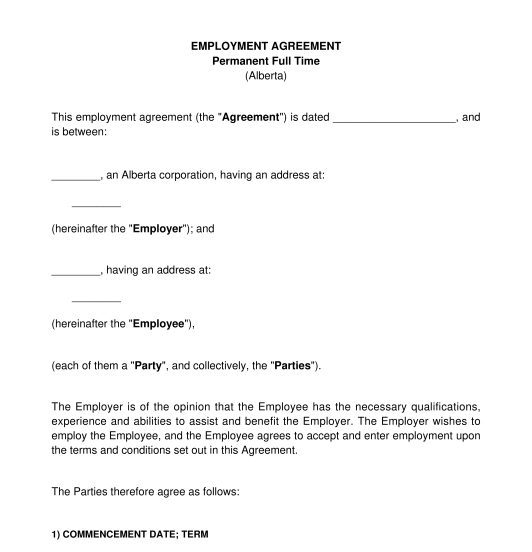 04/09/2025
04/09/2025

Answer a few questions and your document is created automatically.

Your document is ready! You will receive it in Word and PDF formats. You will be able to modify it.




Rating: 4.6 - 74 votes
Fill out the templateAn Employment Agreement is a contract between an employer and employee that outlines the terms of their relationship, such as the employee's salary and duties.
The relationship between an employer and employee is contractual even if no written document has been signed, and a written employment contract will add a degree of certainty about the terms of the employer-employee relationship, and both employer and employee will be protected should any dispute about the employment arise.
How to use this document
This document contains a certain number of essential features, including:
In addition, this document sets out the employee's rate of pay and how and when payment will occur, and provides the employer with some flexibility to change the employee's job description.
An employment contract cannot violate the minimum statutory standards for minimum wage, timing of payment, maximum hours of work and payment for overtime, which are contained in provincial and territorial statutes cited below. There are also minimum statutory standards for notice of dismissal. If a clause breaches the statutory minimum standard for notice of dismissal, a court may replace the clause with the longer common law notice period, an issue that this document addresses by referring to the statutory minimums.
This document also includes a confidentiality clause, and allows for other restrictive covenants to protect the legitimate proprietary interests of the employer and outline the scope of information which is deemed to be confidential, the duration of the restrictions, and the geographic area which the restrictions cover in order for the restrictive covenants to be enforceable. These clauses will restrict the rights of a former employee to compete with their former employer and to disclose confidential information learned while on the job.
Applicable Laws
In the area of employment law, the federal government only has jurisdiction over specific works and undertakings within exclusive federal constitutional jurisdiction, such as shipping, railways and banks. Therefore, the vast majority of employment relationships are governed by the laws of the province in which they are located.
All Canadian provinces have enacted legislation setting out minimum standards that govern the basic terms and conditions of employment, including minimum wage levels, vacation and holiday pay, hours of work, leaves of absence, notice periods for termination, and, in some jurisdictions, severance payments. Employers and employees are not permitted to contract out of these minimum standards, which are contained in the following legislations:
Alberta: Employment Standards Code (RSA 2000, Chapter E-09)
British Columbia: Employment Standards Act (RSBC, c 113)
Manitoba: Employment Standards Code (CCSM, c E110)
Northwest Territories: Employment Standards Act (SNWT 2008, c 13)
Nova Scotia: Labour Standards Code (RSNS, 1989, c 246)
Nunavut: Labour Standards Act (RSNWT (Nu) 1988, c L-1)
Ontario: Employment Standards Act (SO 2000, c 41)
New Brunswick: Employment Standards Act (SNB, c E-7.2)
Saskatchewan: Saskatchewan Employment Act (SS, S-15.1)
Yukon: Employment Standards Act (RSY 2002, c 72)
How to modify the template
You fill out a form. The document is created before your eyes as you respond to the questions.
At the end, you receive it in Word and PDF formats. You can modify it and reuse it.
Guides to help you
Employment Agreement - Sample, template - Word and PDF
Country: Canada (English)